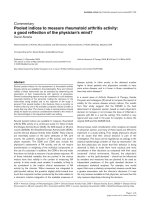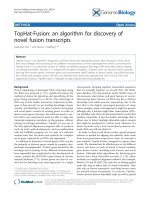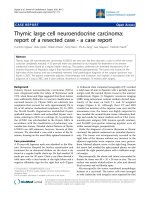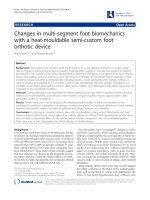Báo cáo y học: "Fluids in septic shock: too much of a good thing" doc
Bạn đang xem bản rút gọn của tài liệu. Xem và tải ngay bản đầy đủ của tài liệu tại đây (121.13 KB, 2 trang )
Introduction
In a recent issue of Critical Care, Brandt and coworkers
[1] performed fl uid resuscitation on pigs with endo tox-
emia or fecal peritonitis using either moderate volumes
of crysta l loids (10ml/kg/h) or larger volumes of crystal-
loids supple mented by 130/0.4 hydroxyethyl starch (com-
bined 20 ml/kg/h). ese protocols were designed to
mimic the relative ‘restrictive’ and ‘liberal’ fl uid resusci-
tation policies that have been previously compared in
human major surgery and acute lung injury/acute
respira tory distress syndrome [2-4]. In both sepsis
models, mortality increased with ‘liberal’ fl uid loading
protocols in spite of better haemo dynamic stabi liza tion.
is interesting study raises a number of questions.
Volume and type of uid in the resuscitation from
sepsis
Although supplemental hydroxyethyl starch use in both
study arms was partially ‘goal-directed’ - on the basis of
cardiac output responses assessed by esophageal Doppler -
the doses used for fl uid loading were relatively fi xed
rather than completely based on cardiac fl uid responses
(fl uid responsiveness). e latter is preferable at the
bedside, even if we do not formally know whether such
therapy causes less morbidity and mortality in septic
shock than using fi xed volumes or guiding infusion
according to relatively crude hemodynamics, such as the
central venous pressure, as currently recommended [5].
It is likely, however, that tailored ‘liberal’ therapy
decreases the risk for iatrogenic and detrimental fl uid
overload compared to fi xed ‘liberal’ therapy [6-8]. e
debate about fi xed ‘restrictive’ versus ‘liberal’ versus ‘goal-
directed’ therapy in the case of major surgery is also
unresolved [2,3,9]. Diff ering results among studies, which
may relate to diff ering case mixes, defi nitions, hemo-
dynamic monitoring techniques/endpoints and treatment
strategies, preclude unequivocal conclusions [9].
e authors used diff erent types of fl uid in the
‘restrictive’ and ‘liberal’ arms, with hydroxyethyl starch
used particularly in the latter. A toxic eff ect of
hydroxyethyl starch can not thus be ruled out, so it is
possible that the higher mortality in the ‘liberal’ arm was
caused, in part, by toxicity rather than large volumes.
Indeed, mortality in the control non-septic pigs receiving
the ‘liberal’ protocol was 13% (1 out of 8). Toxicity may
include renal damage, as was particularly noted from the
histology of the ‘liberal’ endotoxin-challenged animals. In
any case, the histology of several tissues suggested that
overhydration and (pulmonary) edema had not increased
in the ‘liberal’ compared to the ‘restrictive’ fl uid loading
groups, even in the presence of so-called colloid plaques
observed in lungs, for instance, although the nature of
these remains relatively unclear. Finally, starch prepara-
tions may have multiple anti-infl ammatory eff ects, but
we do not know whether this is good or bad during sepsis
[10]. Collectively, the experiments reported raise the
interest ing idea that too much of a good thing is
detrimental, whether related to relative overtreatment or
to toxicity of the hydroxyethyl starch colloid.
A comparison of these experimental results with the
literature is diffi cult because of, for example, highly
varying study goals and endpoints. Morisaki and colleagues
[11] found that starches (more so than Ringers lactate)
Abstract
In a recent issue of Critical Care, Brandt and colleagues
report the e ects of a ‘liberal’ uid loading protocol
compared to a more ‘restrictive’ protocol on
hemodynamics and mortality in pigs in which septic
shock had been induced. It appears that the former
protocol was associated with higher mortality in spite of
improved hemodynamics compared to the latter. The
results of the paper are discussed here in view of the
scope and mechanisms of these ndings. With regard
to uid resuscitation, they indicate that too much of an
otherwise good thing is harmful, even if overhydration
and edema formation seem to have been prevented.
They also do not exclude a speci c toxic e ect of the
larger volumes of hydroxyethyl starch in the ‘liberal’
strategy. The precise nature of a toxic e ect remains
obscure, however, but may involve the kidneys.
© 2010 BioMed Central Ltd
Fluids in septic shock: too much of a good thing?
AB Johan Groeneveld*
See related research by Brandt et al., />COMMENTARY
*Correspondence:
Department of Intensive Care, Vrije Universiteit Medical Centre, De Boelelaan 1117,
1081 HV Amsterdam, The Netherlands
Groeneveld Critical Care 2010, 14:101
/>© 2010 BioMed Central Ltd
ameliorated progression of microvascular and paren-
chymal injury during the development of peritonitis in
sheep. Su and colleagues [12] noted that starch, albumin,
gelatin and Ringers lactate fl uid resuscitation aff orded
similar survival benefi ts during protracted fecal perito-
nitis in sheep, in spite of greater hemodynamic eff ects
with the fi rst two. is illustrates that the current data
provided by Brandt and colleagues [1] may need to be
confi rmed. e observations that hemodynamic and
mortality endpoints may not go in the same direction
also deserve further explanation.
Clinical implications
What are the clinical implications of these experimental
results? e potential but unconfi rmed (renal) toxicity of
hydroxyethyl starch is indeed a subject of ongoing
research in human septic shock and the current
experimental observations may further fuel these eff orts
[13-15]. For instance, the potential renal toxicity of starch
preparations may depend on volume, type, substitution
of starch and the underlying condition of patients in
whom fl uids are infused, so that general conclusions are
hard to draw at this stage [13-15]. at colloids have
greater hemodynamic eff ects, for a given fl uid infusion
volume, than crystalloids, even in sepsis with increased
permeability and potential leakage of the compounds, is
corroborated by recent clinical observations [16].
Conclusion
e outcome benefi ts and drawbacks of fl uid resusci-
tation in sepsis and shock may not solely relate to
hemodynamic eff ects, so that more is not always better,
even if overt overhydration and (pulmonary) edema do
not occur. e experimental fi ndings remind us that
outcome may also be a matter of the type of fl uid used for
initial resuscitation during septic shock. Obviously, this
relates, among other factors, to the increasing evidence
that starch solutions have important side eff ects,
particularly when exceeding recommended maximum
daily doses. Further comparative research is needed.
Competing interests
The author declares that he has no competing interests.
Published: 19 January 2010
References
1. Brandt S, Regueira T, Bracht H, Porta F, Djafarzadeh S, Takala J, Gorrasi J,
Borotto E, Krejci V, Hiltebrand LB, Bruegger LE, Beldi G, Wilkens L, Lepper PM,
Kessler U, Jakob SM. E ect of uid resuscitation on mortality and organ
function in experimental sepsis models. Crit Care 2009, 13:R186
2. Giglio MT, Marucci M, Testini M, Brienza N: Goal-directed haemodynamic
therapy and gastrointestinal complications in major surgery: a meta-
analysis of randomized controlled trials. Br J Anaesth 2009, 103:637-646.
3. Rahbari NN, Zimmermann JB, Schmidt T, Koch M, Weigand MA, Weitz J: Meta-
analysis of standard, restrictive and supplemental uid administration in
colorectal surgery. Br J Surg 2009, 96:331-341.
4. Stewart RM, Park PK, Hunt JP, McIntyre RC Jr, McCarthy J, Zarzabal LA,
Michalek JE; National Institutes of Health/National Heart, Lung, and Blood
Institute Acute Respiratory Distress Syndrome Clinical Trials Network: Less is
more: improved outcomes in surgical patients with conservative uid
administration and central venous catheter monitoring. J Am Coll Surg
2009, 208:725-735.
5. Dellinger RP, Levy MM, Carlet JM, Bion J, Parker MM, Jaeschke R, Reinhart K,
Angus DC, Brun-Buisson C, Beale R, Calandra T, Dhainaut JF, Gerlach H, Harvey
M, Marini JJ, Marshall J, Ranieri M, Ramsay G, Sevransky J, Thompson BT,
Townsend S, Vender JS, Zimmerman JL, Vincent JL; International Surviving
Sepsis Campaign Guidelines Committee; American Association of Critical-
Care Nurses; American College of Chest Physicians; American College of
Emergency Physicians; Canadian Critical Care Society; European Society of
Clinical Microbiology and Infectious Diseases; European Society of Intensive
Care Medicine; et al.: Surviving Sepsis Campaign: international guidelines
for management of severe sepsis and septic shock: 2008. Crit Care Med
2008, 36:296-327.
6. Alsous F, Khamiees M, DeGirolamo A, Amoateng-Adjepong Y, Manthous CA:
Negative uid balance predicts survival in patients with septic shock: a
retrospective pilot study. Chest 2000, 117:1749-1754.
7. Groeneveld AB, Polderman KH: Acute lung injury, overhydration or both?
Crit Care 2005, 9:136-137.
8. Sakr Y, Vincent JL, Reinhart K, Groeneveld J, Michalopoulos A, Sprung CL,
Artigas A, Ranieri VM; Sepsis Occurence in Acutely Ill Patients Investigators:
High tidal volume and positive uid balance are associated with worse
outcome in acute lung injury. Chest 2005, 128:3098-3108.
9. Bundgaard-Nielsen M, Secher NH, Kehlet H: ‘Liberal’ vs. ‘restrictive’
perioperative uid therapy - a critical assessment of the evidence. Acta
Anaesthesiol Scand 2009, 53:843-851.
10. Matharu NM, Butler LM, Rainger GE, Gosling P, Vohra RK, Nash GB:
Mechanisms of the anti-in ammatory e ects of hydroxyethyl starch
demonstrated in a ow-based model of neutrophil recruitment by
endothelial cells. Crit Care Med 2008, 36:1536-1542.
11. Morisaki H, Bloos F, Keys J, Martin C, Neal A, Sibbald WJ: Compared with
crystalloid, colloid therapy slows progression of extrapulmonary tissue
injury in septic sheep. J Appl Physiol 1994, 77:1507-1518.
12. Su F, Wang Z, Cai Y, Rogiers P, Vincent JL: Fluid resuscitation in severe sepsis
and septic shock: albumin, hydroxyethyl starch, gelatin or Ringer’s lactate-
does it really make a di erence? Shock 2007, 27:520-526.
13. Brunkhorst FM, Engel C, Bloos F, Meier-Hellmann A, Ragaller M, Weiler N,
Moerer O, Gruendling M, Oppert M, Grond S, Oltho D, Jaschinski U, John S,
Rossaint R, Welte T, Schaefer M, Kern P, Kuhnt E, Kiehntopf M, Hartog C,
Natanson C, Loe er M, Reinhart K, German Competence Network Sepsis
(SepNet): Intensive insulin therapy and pentastarch resuscitation in severe
sepsis. N Engl J Med 2008, 358:125-139.
14. Wiedermann C: Systematic review of randomized clinical trials on the use
of hydroxyethyl starch for uid management in sepsis. BMC Emerg Med
2008, 8:1-8.
15. Boldt J. PRO: hydroxyethylstarch can be safely used in the intensive care
patient-the renal debate. Intensive Care Med 2009, 35:1331-1336.
16. Trof RJ, Sukul SP, Twisk JWR, Girbes ARJ, Groeneveld ABJ: Greater cardiac
response of colloid than saline uid loading in septic and non-septic
critically ill patients with clinical hypovolaemia. Intensive Care Med, in press.
Groeneveld Critical Care 2010, 14:101
/>doi:10.1186/cc8201
Cite this article as: Groeneveld ABJ: Fluids in septic shock: too much of a
good thing? Critical Care 2010, 14:101.
Page 2 of 2









